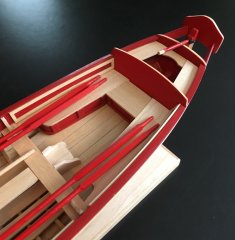-
Posts
1,323 -
Joined
-
Last visited
Content Type
Profiles
Forums
Gallery
Events
Everything posted by Tigersteve
-
Thanks, Ryland. It's pretty difficult. Maybe more so than Chuck's longboat. Steve
- 190 replies
-
- pinnace
- model shipways
-
(and 1 more)
Tagged with:
-
Halfway through hull planking. It's not as seamless as desired. I decided to check the remaining space at the stern. My initial measurements did not show a need for tapering. This is incorrect. Next steps will be to line off the hull towards the stern for the remaining five planks on each side. Steve
- 190 replies
-
- pinnace
- model shipways
-
(and 1 more)
Tagged with:
-
Take your time, Mike. It's going to turn out great. Steve
- 843 replies
-
- niagara
- model shipways
-
(and 2 more)
Tagged with:
-
That's looking good. I can't wait to complete the outer hull planking! Steve
- 156 replies
-
- pinnace
- model shipways
-
(and 1 more)
Tagged with:
-
Thank you for the nice comments and likes! Let's talk about the stern for a moment. As we know, a 90 degree twist is needed to get the plank to conform to the shape of the hull. What's also needed is a slight edge-bend towards the keel to get the plank to butt up against the previously laid plank. That's the easy part. Bending and shaping the plank at the bow is done first. Here are the steps: 1. Create a severe edge-bend using dry heat and let the plank cool completely. 2. Hold the plank to the previously laid plank and note where to snip off the excess. 3. Sand the edge of the plank smooth and at a slight angle to fit into the rabbet. 4. Mark the first few bulkhead locations onto the plank to form the taper. 5. Bend and twist the plank and dry fit into the rabbet for a tight fit. 6. Clamp the entire plank to the hull and add heat. (Steps 5 and 6 are done several times until the plank fits properly.) The plank is then glued. This process takes a while and is not easy. None of these strategies are new. This is just the way I've applied what I learned from other modeler's logs and methods. Steve
- 190 replies
-
- pinnace
- model shipways
-
(and 1 more)
Tagged with:
-

US Brig Syren by knightyo
Tigersteve replied to knightyo's topic in - Build logs for subjects built 1801 - 1850
Nice work so far. Steve -
Wow- you finished all that in a week? Welcome aboard. Look forward to more updates. Steve
- 23 replies
-
- finished
- 18th century longboat
-
(and 1 more)
Tagged with:
-

Swan class 3D model in progress
Tigersteve replied to dvm27's topic in CAD and 3D Modelling/Drafting Plans with Software
Cool stuff. Going to follow this one. Steve- 141 replies
-
- pof swan series
- swan
-
(and 1 more)
Tagged with:
-
Congrats! Looks great! Steve
- 164 replies
-
- model shipways
- armed virginia sloop
-
(and 2 more)
Tagged with:
-
The series of sub-assemblies and the final construction in your last post really illustrates how complex the rigging is on these ships. Beautifully done. Steve
- 3,618 replies
-
- young america
- clipper
-
(and 1 more)
Tagged with:
-
The first six bulkheads were shimmed port and starboard. This allowed the next plank from the garboard a better fit into the rabbet. The port side plank remains to be fitted. After this is complete the hull will be lined off. Each plank fitted is a small victory. Steve
- 190 replies
-
- pinnace
- model shipways
-
(and 1 more)
Tagged with:
-

US Brig Syren by knightyo
Tigersteve replied to knightyo's topic in - Build logs for subjects built 1801 - 1850
Echo Dirk here. Save your energy for the carvings, which are coming along nicely. Steve
About us
Modelshipworld - Advancing Ship Modeling through Research
SSL Secured
Your security is important for us so this Website is SSL-Secured
NRG Mailing Address
Nautical Research Guild
237 South Lincoln Street
Westmont IL, 60559-1917
Model Ship World ® and the MSW logo are Registered Trademarks, and belong to the Nautical Research Guild (United States Patent and Trademark Office: No. 6,929,264 & No. 6,929,274, registered Dec. 20, 2022)
Helpful Links
About the NRG
If you enjoy building ship models that are historically accurate as well as beautiful, then The Nautical Research Guild (NRG) is just right for you.
The Guild is a non-profit educational organization whose mission is to “Advance Ship Modeling Through Research”. We provide support to our members in their efforts to raise the quality of their model ships.
The Nautical Research Guild has published our world-renowned quarterly magazine, The Nautical Research Journal, since 1955. The pages of the Journal are full of articles by accomplished ship modelers who show you how they create those exquisite details on their models, and by maritime historians who show you the correct details to build. The Journal is available in both print and digital editions. Go to the NRG web site (www.thenrg.org) to download a complimentary digital copy of the Journal. The NRG also publishes plan sets, books and compilations of back issues of the Journal and the former Ships in Scale and Model Ship Builder magazines.


